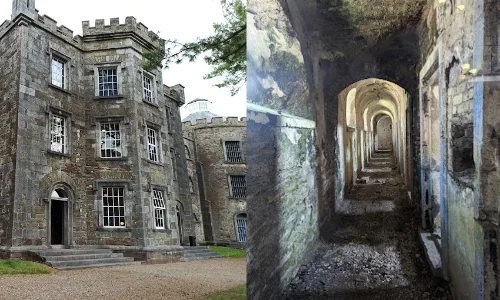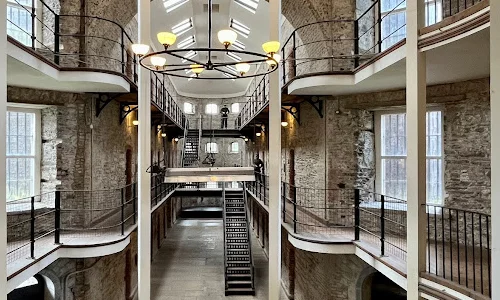Opening Hours
- Open daily from 10 am to 4 pm
- Guided Tour at 2 pm daily
Ticket Prices
- Adult: €11
- Student: €9
- OAP: €9
- Child: €7
- Family: €34
Visit the Cork City Gaol website to book tickets.
Table of Contents
Exploring Cork City Gaol – A Journey Through Time

Embarking on a visit to Cork City Gaol is not just a tour; it’s a journey through the annals of 19th-century prison life. As you step onto the grounds, you’re met with an opportunity to delve into the history and stories that echo within these storied walls.
Cork has some fantastic historical places to visit such as the Cork City Gaol. For more information, read my article on some of the best Castles in Cork, Ireland.
Insights into 19th-Century Prison Life:
Your visit promises a unique insight into the realities of life within a 19th-century prison. Wander through the corridors that once echoed with footsteps of both the incarcerated and the guards. Experience the ambience of a bygone era as you explore the austere cells and communal areas.
Locked into History:
For a truly immersive experience, dare to be locked into a cell—a momentary glimpse into the confinement experienced by those who once called Cork City Gaol home. One of the notable cells, as remarked by Countess Markievicz, is known as “the most comfortable jail.” It’s a chance to distinguish between historical confinement and the present day.
Guided Tours for All:
Knowledgeable tour guides are available daily throughout the year to enhance your exploration. Everyone is welcome, whether you’re part of a school group, an English language college, a tour group, an active retirement group, or a large family gathering. These experienced guides are well-equipped to provide informative and engaging tours tailored to the interests of diverse groups.
Educational Opportunities:
Cork City Gaol warmly welcomes primary and secondary schools, offering students a unique educational experience. The guided tours are designed to bring history to life, enriching them for students of all ages.
Special Interest Groups:
The Gaol caters to various special interest groups, allowing enthusiasts to delve deeper into specific aspects of its history. Whether your interest lies in architecture, social history, or the tumultuous events of the Irish Civil War, there’s something for every curious mind.
Family-Friendly Experience:
For large family groups, Cork City Gaol provides an opportunity to connect with Irish history meaningfully and family-friendly. Engage the younger generation with the past while creating lasting memories during your visit.
Year-Round Accessibility:
No matter the season, Cork City Gaol welcomes visitors. With guided tours available daily, you can plan your visit at your convenience, making it an accessible and enriching experience throughout the year.
Embark on this journey through time at Cork City Gaol, where every corridor and cell tells a story, and every step brings you closer to understanding the complex tapestry of Ireland’s history.
Unveiling the History of Cork City Gaol

Cork City Gaol is a testament to Ireland’s rich history, dating back to the early 19th century.
In 1806, spurred by the dire conditions of the old Gaol at North Gate Bridge, which was nearly a century old, overcrowded, and unhygienic, an Act of Parliament was passed to pave the way for constructing a new facility.
Distillery Fields (Corks North Mall) was initially chosen as the site. A more suitable location was sought for the new Cork City Gaol due to its susceptibility to flooding. The eventual choice, Sunday’s Well, proved advantageous due to its elevated position. It was believed then that using a high position would help contain the spread of “gaol fever” or typhus.
The ambitious project, including the site, approach roads, and perimeters, commenced in 1816, with the gaol construction beginning in 1818.
These efforts culminated with the grand opening of the new Cork City Gaol in 1824, heralded as “the finest in 3 kingdoms.”
Designed by William Robertson of Kilkenny and constructed by the esteemed Deane family, the Gaol was more than a mere correctional facility; it was a statement of architectural prowess and a response to the need for improved living conditions for prisoners.
In 1870, recognizing the evolving needs of the time, the west wing underwent a significant transformation, evolving into a double-sided cell wing that added a new dimension to the prison’s structure and functionality.
At its inception, Cork City Gaol was the residence for male and female prisoners whose transgressions occurred within the city’s boundaries.
Offenders outside this jurisdiction were incarcerated across the river at Cork County Gaol, near University College Cork.
The notable involvement of sculptor John Hogan, who contributed as a draughtsman during the building’s construction, adds an artistic touch to its historical significance.
Today, Cork City Gaol preserves the stories of its incarcerated past. It is a living monument to the architectural and social developments that shaped 19th-century Ireland.
Womens Gaol

Evolution into a Women’s Prison (1878-1900s)
A pivotal moment in the history of Cork City Gaol occurred in 1878 with the enactment of the General Prisons (Ireland) Act.
This legislation brought about a reorganization of prisons in Cork, reshaping the role of Cork City Gaol. Under the new arrangement, the Gaol transitioned into a women’s prison, serving Cork City and County.
Simultaneously, the Cork County Gaol near University College Cork became the designated men’s prison for the region.
The day of this significant change is etched in history, as male prisoners marched out of Sunday’s Well Prison to the Western Road Gaol.
In contrast, female prisoners made the journey in the opposite direction. This began Cork City Gaol’s role as a women’s correctional facility.
During the late 19th century, a peculiar aspect of the prison’s inmate population emerged. Many of the incarcerated individuals were repeat offenders held for offences that, by contemporary standards, might not warrant imprisonment.

An illustrative example is the case of Mary Tucker from Rathmore in County Cork. Between 1849 and 1908, Mary found herself imprisoned multiple times, facing charges such as ‘Obscene Language’ or ‘Drunkenness’.
As the 20th century unfolded, Cork City Gaol played a role in the tumultuous events of Irish history. Amidst the Irish War of Independence, Republican women prisoners found themselves confined within its walls, becoming a living testament to the political upheaval of the time.
In October 1919, Cork City Gaol housed Constance Markievicz, a trailblazing figure who had become the first woman elected to the British Parliament.
Her imprisonment in Cork City Gaol was a result of delivering a seditious speech.
Shortly after that, in January 1919, Mary Bowles, a member of Cumann na mBan, faced imprisonment for arms offences, contributing to Cork City Gaol’s continued role in the Irish struggle for independence.
The era also witnessed daring escapes, with Republican prisoner Dolly Burke making a successful break from the prison confines in January 1919.
This chapter in Cork City Gaol’s history adds complexity to its narrative, showcasing its evolution from a mixed-gender prison to a facility focusing on female incarceration.
Today, visitors can explore these rich historical layers, gaining insights into the lives of those who once called Cork City Gaol home.
Cork City Gaol During the Irish Civil War (1922-1923)

The pages of Cork City Gaol’s history turned darker during the tumultuous years of the Irish Civil War in 1922 and 1923.
The prison, initially designed as a women’s correctional facility, found itself compelled to reopen its gates to both male and female Republican (anti-treaty) prisoners caught in the throes of the conflict.
The renowned author, Frank O’Connor, was confined within the stark confines of Cork City Gaol during this period. Arrested for his involvement in the Civil War, O’Connor became a witness to the transformation of Cork City Gaol into a unisex prison due to the surge in arrests.
The repercussions of this decision were profound. Cork City Gaol, originally designed to accommodate female inmates, now faced the challenge of overcrowding.
Frank O’Connor shared a cell with three others, highlighting the cramped conditions that characterized this chapter of Cork City Gaol’s history.
The prison became a harsh microcosm of the war raging outside its walls. Infestations of rats and mice, lice-covered blankets, and the daily spectre of executions cast a grim shadow over the incarcerated. The chilling echoes of abuse, screams, and gunfire, followed by an unsettling silence, became the haunting soundtrack of daily life within the prison.
Some inmates, unable to endure the ordeal, chose a tragic escape by throwing themselves off the side of the staircase. The psychological toll was evident as two of Frank O’Connor’s cellmates resorted to nightly prayers, finding solace in saying the rosary amid the turmoil.
Despite the grim circumstances, a peculiar camaraderie emerged. Frank O’Connor and Cremin, his fourth cellmate, an ex-British army man who fought against the Germans in World War, engaged in a surreal coping mechanism.
They found release and distraction by singing “songs against one another,” perhaps a testament to the resilience of the human spirit even in the face of adversity.
Cork City Gaol, a witness to the clash of ideologies and the human cost of political strife, bore witness to these harrowing moments during the Irish Civil War.
Cork City Gaol closed in August 1923, with all remaining prisoners either released or transferred to other prisons.
Today, the Gaol stands as a living monument to this period, allowing visitors to delve into the complexities of its role in one of Ireland’s most challenging historical chapters.
Related Articles:
- Find somewhere to eat in my Best Restaurants in Cork article.
- Get lunch from one of my Best Places for Lunch in Cork City.
- Get a taste of Cork in some of Cork’s Best Pubs with live music.
How long does it take to visit Cork City Gaol?
In total, you could spend 2hrs visiting the City Gaol. Getting a tour(available for an additional €2) takes up a good chunk of this time, and afterwards, you get to roam freely around the Gaol to soak up the atmosphere and take all those valuable snaps.
Is Cork City Gaol free?
Cork City Goal is a paid-for attraction. The admission rate is €11 for adults, €9 for seniors and students, €7 for children and €34 for a family ticket.
